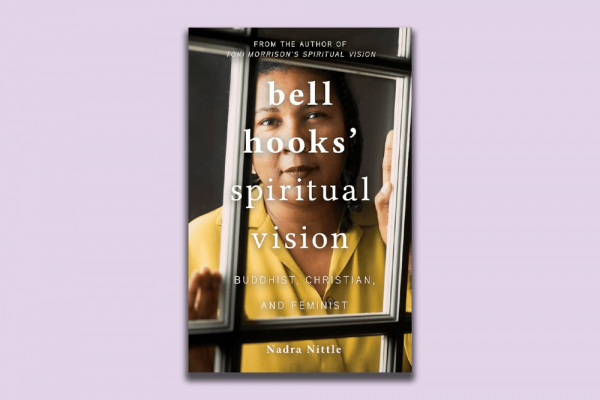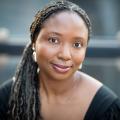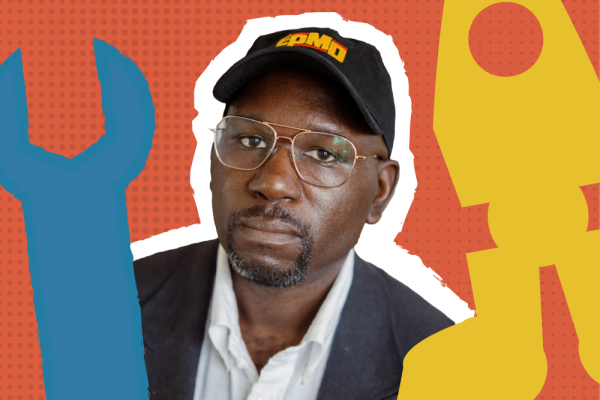Originally published by The 19th
Nearly two years have passed since feminist bell hooks died of renal failure on December 15, 2021. The writer of more than three dozen books was widely remembered for her contributions to feminism, cultural criticism, and scholarship — not to mention her decision to lowercase her pen name, chosen in honor of her great-grandmother, Bell Blair Hooks.
But above all, hooks viewed herself as a Buddhist-Christian, a hybrid religious identity that few obituaries in the mainstream press mentioned. Endorsed by three of hooks’ friends — Lynnée Denise, Silas House, and Beth Feagan — my new book, “bell hooks’ Spiritual Vision: Buddhist, Christian, and Feminist,” examines the important role that the feminist’s faith played in her life and writing.
Having attended Baptist churches while growing up in her native Kentucky, hooks first took an interest in Buddhism as a college student in California in the 1970s. In the tradition of the Rev. Martin Luther King Jr. and the Buddhist monk Thích Nhất Hạnh, hooks’ spirituality informed her social action.
The following excerpt from “bell hooks’ Spiritual Vision” explores her belief that women’s liberation and spirituality go hand-in-hand, as many feminists believe that confronting patriarchy requires them to challenge, or find alternatives to, religions that characterize women as inferior to men.
A Feminist Approach to Spirituality
In both her church and her campus ministry, Gloria Jean Watkins learned to love and accept herself despite growing up in a household where she perpetually felt rejected. By adulthood, she’d gained the confidence to pursue a career as a writer and a scholar, fashioning a new identity — bell hooks — for herself in the process. In “Feminism Is for Everybody,” hooks’ 2000 primer on the women’s liberation movement, she reveals that achieving self-love and self-acceptance was critical to her personal development, as she would not have become a fully realized person without them.
When hooks first took part in the feminist movement as a college student in the 1970s, she also learned about the importance of loving herself. In consciousness-raising groups, feminists sought to heal themselves from the “patriarchal assaults” they experienced in their families of origin or intimate relationships. In these therapeutic feminist circles, women were affirmed spiritually and emotionally. Perhaps because the message she received about self-love and self-acceptance in religious environments and in feminist circles echoed each other, she did not view being a feminist of faith as a contradiction. In fact, she argues in her primer, “Feminism has been and continues to be a resistance movement which valorizes spiritual practice.”
Feminists of the 19th and early 20th centuries led the modern spiritualism movement while advancing causes such as women’s suffrage and the abolition of slavery. Their counterparts in the 1960s, ’70s, and ’80s practiced what hooks calls “creation spirituality” or “goddess-centered spirituality,” types of neopaganism also embraced by 21st-century feminists fighting for equal pay, reproductive rights, and an end to sexual violence. Those gender equality advocates involved in organized religion championed feminist, womanist, and mujerista theologies to highlight the role of women in such traditions.
No matter the time period, women who’ve fought for gender, racial, economic, or LGBTQ+ equality have paired their activism with spiritualities that honor the sacred feminine. They understood that empowerment in both the sociopolitical and spiritual realms is necessary for women to realize their human potential. This recognition led feminists to reject or reinterpret religions that suggest women are inherently evil, deceitful or inferior to men.
hooks was one such feminist. She sought out the divine feminine in Buddhism and Christianity alike. Having encouraged women to leave fundamentalist religions, she embraced the mystical Christianity and African-derived spirituality of her elders. But she also made a point to recognize the divinity of nature, revealing pagan inclinations. Women are served best, she believed, by practicing the traditions they connect to most. That’s the case even if it means engaging in syncretism or blending religions together.
Honoring the sacred feminine
Historically, women have shown remarkable resilience as followers of religions that relegate them to the sidelines. In “Feminism Is for Everybody,” hooks notes that, for centuries, women have taken action to find “solace and sanctuary” in patriarchal religions. “Throughout the history of the church in Western life women have turned to monastic traditions to find a place for themselves where they can be with god without the intervention of men, where they can serve the divine without male domination.”
To back up her argument, hooks points to the English mystic Julian of Norwich, who lived during the Middle Ages from 1342 to about 1416. Although she is sometimes called Juliana of Norwich, Mother Julian, the Lady Julian, and Dame Julian, her real identity remains unknown. The name Julian refers to St. Julian’s Church in Norwich, where the mystic known for her book, “Revelations of Divine Love,” spent most of her life as an anchoress — a woman cloistered in a cell to dedicate her days and nights to prayer and meditation. Julian is an historically important figure both because of her spiritual insight and because of the belief that she was the first woman to write a book in English.
On May 8, 1373, a day she thought would be her last, an image of a bleeding Christ appeared before her. The 16 visions Julian saw while believing she lay dying deepened her understanding of Christ, including his suffering and love for humanity. The experience inspired her to write “Revelations of Divine Love,” the book that is now considered a spiritual classic and has been cited by influential 20th-century writers such as Iris Murdoch and T. S. Eliot.
In this text, Julian trusts God while exploring doubt and fear from a theological perspective. Julian was a spiritual advisor to the people of Norwich, a community that endured famine, plague, and poverty during her lifetime. Her words comforted the suffering. For example, she writes in chapter 45 of “Revelations of Divine Love,” “Peace and love are always in us, being and working, but we are not always in peace and love. But he wants us to pay attention to this: that he is the foundation of our whole life in love.”
hooks was a youth when she first took an interest in exploring love through a spiritual and emotional lens, so her attraction to Julian of Norwich is hardly a mystery. But Julian’s writing about divine love was not the only reason hooks felt drawn to her. The reclusive mystic’s framing of divinity as feminine appealed to hooks as well. hooks explains,
With keen spiritual insight and divine clarity the mystic Julian of Norwich would write long before the advent of contemporary feminism: “Our savior is our true mother in whom we are endlessly born and out of whom we shall never come.” Daring to counter the notion of our savior is always and only male Julian of Norwich was charting the journey back to the sacred feminine, helping to free women from the bondage of patriarchal religion.
Using Julian as a model, hooks demonstrates how women of devout faith — Christian faith, at that — have longed to see themselves represented as divine. Before Christianity, agrarian societies worshipped ancient goddesses painted black, purportedly because the most fertile soil is the darkest in hue. When Christianity spread, its leaders are said to have appropriated these images, giving rise to paintings of the Virgin Mary as dark-skinned. Imagery of the Black Madonna inspired hooks, who made a pilgrimage to the Shrine of the Black Madonna in Montserrat. Observing the statue “nourished my soul,” hooks states in “Homegrown.” “This image of a beautiful, dark Madonna, blessing and healing the world, is counter hegemonic: It challenges the equation of Blackness with ugliness.”
The Shrine of the Black Madonna affirmed hooks’ race and sex, allowing her to reimagine Christianity from a Black female perspective. The scholar’s desire to engage a feminist spirituality was not unusual. In “Feminism Is for Everybody,” hooks describes how the second wave feminist movement that began in the 1960s and continued through the 1980s overlapped with a countercultural shift away from fundamentalist religion. This trend mirrored the spiritualist movement of the 19th century. Then, women’s rights activists fighting for suffrage, property rights, and temperance (since alcoholic men often committed domestic violence or impoverished their families) turned increasingly to spiritualism, a Christian offshoot later deemed an independent religion. When the 1848 Seneca Falls Convention — the nation’s first women’s rights conference — took place, modern spiritualism was spreading throughout the United States.
Inspired by the ideas of eighteenth-century Swedish philosopher Emanuel Swedenborg, whose 1758 book “Heaven and Hell” explores the afterlife, the spiritualism movement was popularized by women such as the Fox sisters, who (falsely) claimed the ability to communicate with a spirit in their Hydesville, New York, home. Spiritualists believed that it was possible to communicate with the dead, a comforting notion during a time when many infants never made it out of childhood, women often died in childbirth, hundreds of thousands of men died during the Civil War, and people of all genders and ages were vulnerable to death by infectious disease.
When spiritualism took off in the mid-1800s, it became one of the limited avenues women had to speak in public. Feminists used the opportunity to advocate for women’s rights and related causes. Spiritualism also gave them cover, as it was easy to blame their progressive politics on messages from spirits.
The spiritualism movement attracted many well-known followers, including Sir Arthur Conan Doyle, First Lady Mary Todd Lincoln, and Sojourner Truth, both a suffragist and an abolitionist. The next wave of feminists did not become devoted spiritualists. However, as they explored solutions to gender inequality, they took an interest in alternative religion.
Politics and paganism
While 19th-century feminists championed spiritualism, second-wave feminists combined politics and paganism. Feminism’s second wave — a term popularized by a March 1968 New York Times Magazine article called “The Second Feminist Wave: What Do These Women Want?” — aligned themselves with a variety of causes. In addition to fighting for reproductive rights and an end to sexual violence, they demanded workplace and antidiscrimination protections. They drew attention to issues including sexuality, marriage, family life, and patriarchal dominance. Many of these women questioned the patriarchy in the Judeo-Christian tradition. They leaned toward New Age and Eastern spirituality and, to a lesser degree, Indigenous and traditional African religions.
In “Feminism Is for Everybody,” hooks recounts how a number of feminists felt emotionally connected to the female deities they encountered in Hinduism, Buddhism, and Vodou. Today, such women would likely face accusations of cultural appropriation, and, in fact, some of them were colonizing forces on these spiritual traditions — repackaging, marketing, and profiting off practices to which they had no ancestral connection by presenting themselves as experts. Some of these women, however, did have lineal ties to the religious traditions they began practicing, such as Black American women embracing West African spirituality or White American women embracing the paganism of Europe.
“For most of human history, God was present in everything, in animals, in plants, in men, in women, in all races,” feminist leader Gloria Steinem said during a 1993 speech to commemorate the 300th anniversary of the Salem witch trials. “The word ‘pagan’ just means ‘of nature.’ It’s supposed to be a terrible thing, of course, but that’s all it means.”
For Starhawk — author of 1979’s “The Spiral Dance: A Rebirth of the Ancient Religion of the Great Goddess” — learning about paganism as a first-year college student in the late 1960s was life changing. Born Miriam Simos, she took the name Starhawk as an adult after it came to her in a dream, explaining in 2004 that tradition dictates that “when you’re initiated as a witch that you change your name.” Starhawk’s journey to witchcraft was not linear but began while she was working on an anthropology project about witches with a classmate. As Starhawk researched, she discovered “that there was this whole theory about witches being the old pre-Christian pagan religions of Europe,” she said in a 2022 podcast interview. “And now that seems pretty obvious, but at the time, that was a radical idea that there even were pre-Christian religions. And I just thought that was so exciting, and we just got totally into it. We formed a coven.”
Although she and her classmate went on to get training from actual witches, their interest in paganism waned eventually. Then came the women’s liberation movement, renewing Starhawk’s interest in earth-based religions and intensifying her belief that “there should be some connection between feminism and the religion of the Goddess.” Prior to her introduction to paganism, Starhawk had never considered that a deity could be anything other than male. As she explained during her podcast interview,
I was raised Jewish and even though God was supposed to have no gender and no sex and no form, somehow he was always referred to as “he.” And in Hebrew, the language is very, very gendered in a way English is not, where every verb changes according to whether you’re female or male. So it was always in the male form for God. And the idea that you could see God in female form to me was just a radical and very empowering idea, a very affirming idea. Yes, women could actually take leadership because there weren’t a lot of leadership roles in Judaism at that time. It was a few years before the feminist movement started inspiring women to say, “Hey, why shouldn’t we be rabbis? Why shouldn’t we be cantors?”
In “The Spiral Dance,” an introduction to feminist witchcraft, Starhawk emphasizes the link between the divine feminine, Mother Earth, magic, and politics. She asserts that the feminist movement is not only political in nature but also magical and spiritual.
For Black feminists, most of whom grew up in church-going families like hooks did, religion and politics always complemented each other. The Black church, after all, birthed the civil rights movement and, before that, resistance movements against enslavement. Raised in communities where religion and activism had been braided together historically, Black feminists typically already had a politico-spiritual foundation when they joined the women’s liberation struggle.
In her 1983 book, “In Search of Our Mothers’ Gardens: Womanist Prose,” writer Alice Walker uses the term womanism to describe Black feminists and feminists of color. From the term womanish, which older generations of African Americans used to characterize girls who displayed “outrageous, audacious, courageous or willful behavior,” womanists were feminists who had active spiritual lives, among other qualities. A womanist “loves the moon. Loves the spirit,” Walker writes of them.
hooks did not identify as a womanist. She argued that Black women didn’t need a separate term to describe themselves in the feminist movement because the term she coined — “imperialist white supremacist capitalist patriarchy” — captured the interlocking forms of oppression that target them. But she also believed that it was important for feminists of different racial backgrounds to join in solidarity. During a 2015 discussion at Eugene Lang College, hooks said of womanism,
There is no mass-based political movement in our society known as womanism. And there has never been. … I don’t care how much Alice Walker talks about womanism; she [personally] developed within the framework of politicized feminism. … There continues to be a deep hatred between Black women and white women fueled by ongoing competition, fueled by one group feeling that as long as they are at the center, the other group has to be down under. And I think that to some extent, unfortunately, the womanism allowed Black women to feel like, “We got something better going on than white girls; we got womanism.” But, in fact, it took us away from the political significance of what does it even take to build solidarity?
hooks believed that it was more important to stand with women who have “dared to claim feminism” than to claim womanism. In her dismissal of womanism in this instance, however, she suggested that the need some Black women have to separate themselves from the feminist movement is strictly rooted in mutual hatred or competition with White women. This stance ignores the Black women who felt that feminism didn’t address their particular needs or those who experienced covert or overt anti-Black racism in the women’s liberation movement and desired a space whether they would feel safe and seen.
The leaders of the first-wave feminist movement, at times, ignored the existence of Black women altogether. While meeting with abolitionist Frederick Douglass in 1866, women’s rights activist Susan B. Anthony notoriously said, “I will cut off this right arm of mine before I will ever work or demand the ballot for the Negro and not the woman.” To Anthony’s ilk, “woman” equaled White woman exclusively. This problem persisted during the second-wave feminist movement.
Excerpted from: bell hooks’ Spiritual Vision: Buddhist, Christian, and Feminist by Nadra Nittle copyright © 2023 Fortress Press. Reproduced by permission. Available from www.fortresspress.com Nov. 7, 2023.
Got something to say about what you're reading? We value your feedback!







